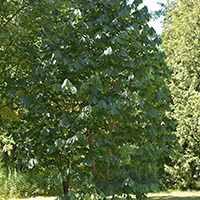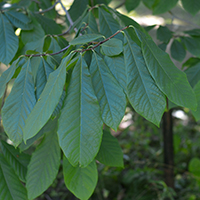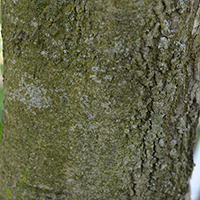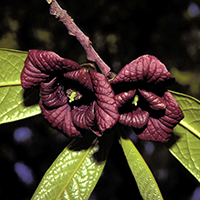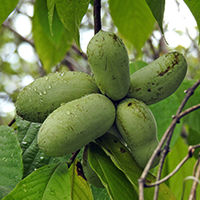What pawpaw looks like
Size and shape
- Reaches 10 metres high.
- Trunk reaches up to 30 centimetres in diameter.
Leaves
- Green, thin leaves with reddish-brown hairs (15 to 30 centimetres).
- Smell unpleasant when bruised.
Bark
- Thin, smooth and dark brown with grey blotches when young.
- Becomes rough with age.
Flowers
- Reddish-purple flowers (4 centimeters) grow in clusters.
- Are attached directly to the stem.
- Have an unpleasant odour.
Fruit
- Cylindrical, yellow-green, fleshy berries (up to 12 centimetres) grow individually or in clusters.
- Each fruit contains several flattened, dark brown seeds.
Where pawpaw is found
Pawpaw is a Carolinian species found in Southwestern Ontario near Lake Erie and in the Niagara Region.
What you need to know to grow pawpaw
- Moisture: grows best in moist, well-drained soils.
- Soil: grows best in nutrient-rich soil with acidic to neutral pH.
- Shade: grows best in part shade.
- Caution: pawpaw trees are not self-pollinating and have few natural pollinators, which can limit fruit production.
Benefits and uses of pawpaw
Wildlife benefits
Pawpaw fruit is a food source for many species, including:
- opossum
- fox
- squirrel
- raccoon
Pawpaw trees are the host plant of the zebra swallowtail butterfly.
Commercial uses
Pawpaw fruit can be turned into pulp and used to make:
- ice cream
- vinaigrette
- preserves
- beer
Fun facts about pawpaw
- Pawpaw sap contains toxic chemicals that prevent herbivores and insects from eating their leaves.
- Pawpaw fruit is said to taste like a combination of banana, pineapple and mango.
- The fruit are the largest of any native tree in North America.
- The unpleasant smell of the flowers attracts beetles and flies as pollinators.
Updated: January 10, 2024
Published: July 18, 2014
